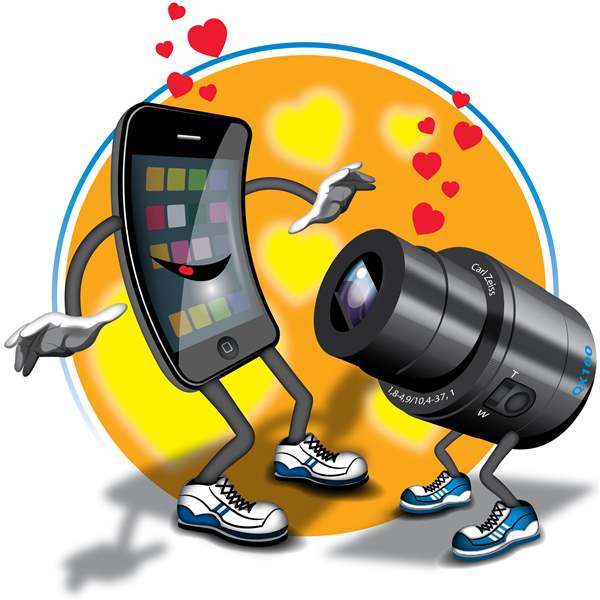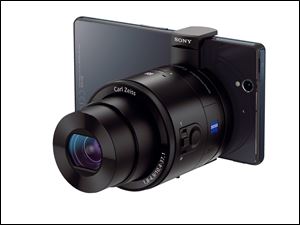
Sony’s offbeat QX100 connects wirelessly to cell phone and it's brilliant
9/28/2013
BLADE ILLUSTRATION BY TOM FISHER

Sony's QX100 camera, which connects wirelessly to a cell phone, offers manual controls, optical image stabilization, a tripod mount, and a Zeiss f/1.8 lens.
Sony’s concept for the new QX100 is among the most brilliant in its history.
Unfortunately, the good idea ended with the concept. By the time the poor QX100 reached the production line, it never really had a chance.
Oh, wait — you want to know what it is?
It’s the answer to a long-simmering problem. Digital cameras take excellent photos but aren’t good at transmitting them. Cell phones are great at sending pictures — but aren’t very good at taking them.
Sony’s masterstroke: Why not create a weird half-a-camera that contains exactly the components that a cell phone camera lacks?
It could have a lens that really zooms. It could contain serious, professional “glass” — a Zeiss f/1.8 lens, with the quality, multiple glass elements, and light-passing capacity that cell phones wouldn’t have in their wildest dreams. It could have manual controls, optical image stabilization, and a tripod mount.
Above all, it could have a huge sensor, the digital “film.” This sensor could measure 1-inch diagonal — more than 40 times the size of a cell phone’s sensor.
A large sensor gives you delicious amounts of detail, true colors, and exceptional clarity in low light. A big sensor means less blur because the shutter doesn’t have to stay open long to let in enough light.
Megapixels, on the other hand, aren’t a very big deal. Even so, Sony’s semicamera could offer 18 or 20 megapixels — enough for even giant prints — compared with the 5 or 8 megapixels on your phone.
So that’s what the QX100 ($500) is. There’s a half-priced junior version too. More on that in a minute.
The QX100 is the craziest-looking camera you’ve ever seen. Even on close inspection, you’d swear it was just a lens. Not a whole camera — just a lens, like maybe one from somebody’s SLR camera. It’s a black cylinder, 2.2 inches long, 2.5 inches across.
Somehow, into that space, Sony has crammed most of a camera. There’s a 3X telescoping zoom with a zoom lever. There’s a real shutter button, a battery, stereo microphones, and a memory-card slot.
There is not, however, a screen, because your phone already has a huge, really great one. So between this lens thing and your phone, you have all the elements of a top-notch photographic machine.
The QX can snap onto a plate bearing rubber-lined grippers. They’re spring-loaded so they can firmly grip your phone. That’s right: You can actually attach a $500, semiprofessional zoom lens to your cell phone and take some truly excellent pictures.
To communicate with your phone, you install the clunkily named app, PlayMemories Mobile.
If you have an Android phone, and it came with an NFC (near-field communication) chip, you now just tap your phone against the QX100. That gesture “pairs” them and opens the app, ready for shooting.

A couple use Sony's QX100 camera to take a photo of themselves. The camera offers a variety of features, from a real shutter button to stero microphones to a memory-card slot and more.
If you have an iPhone or a non-NFC Android phone, things get trickier. You’re supposed to connect your phone to the private Wi-Fi hot spot generated by the QX itself — which, in this case, has nothing to do with the Internet.
Once you have everything set up, the phone’s screen acts as the lens’s viewfinder. Using touch controls on your phone, you can zoom in and out; take a picture by remote control; and adjust the exposure, automatic and program modes, plus aperture priority mode, manual focus, and white-balance options. It all works, although the camera takes part of a second to respond to your phone taps; you should not expect pinpoint timing with your zooming or shuttering.
The QX100 is based on the best pocket camera ever made, the Sony RX100 Mark II ($750). (The Mark II is the successor to the previous best pocket camera ever made, the RX100; the Mark II offers a tilting screen, Wi-Fi transmission to your phone, and even better lowlight photos.)
In other words, the QX’s pictures are truly terrific.
And remember: Just because the lens clips to your phone doesn’t mean it has to. It’s almost more fun to set it down in some awkward place to take pictures nobody else can get: in the crook of a tree, under a car, on a fence post above the crowd blocking your view of the concert. Once the lens is parked, you can stand somewhere nearby, viewing what it sees on your phone, controlling the zoom and exposure and taking remote-controlled photos.
You can even use the QX without the phone, although you can’t see what you’re shooting. You aim by hand and hope for the best.
Each photo’s full-resolution self is stored on the lens’ memory card. A 2-megapixel, more easily uploaded and stored version is transmitted into your phone. (Sony reasons that sending the full 20-megapixel versions would swamp your phone’s storage, although you can change the app’s settings to do just that.)
The QX records movies. They don’t get sent to your phone; they stay on the lens’ memory card. You can transfer them to your computer using the USB cable, which you also use to recharge the lens’ 200-shot battery.
All this works identically on the 18-megapixel QX10, the less expensive sibling. It costs half as much; it’s about half as long and much lighter; and it zooms 10X instead of 3X.
But the QX10 doesn’t offer anything like the photographic excellence of the QX100. Its sensor is no bigger than the ones on standard pocket cameras. Its lens isn’t Zeiss glass, and it’s no f/1.8. And it offers no manual controls except exposure compensation.
And now, the bad news. As it turns out, the QX cameras’ execution just doesn’t live up to the ingenious idea behind them. Some problems:
● The camera requires a cell phone-style memory card, a microSD card (not included), which is about the size of a fingernail clipping.
● Neither “camera” has a flash. And no, you can’t use your phone’s flash to compensate.
● The sensor and lens of the QX100 are the same as what’s in the RX100 Mark II, but it’s otherwise missing a lot of that camera’s features. The QX100 lacks a burst mode, shutter-priority mode, self-timer mode, Illustration mode, and the amazing Sweep Panorama.
● Both cameras take only JPEG photos. They can’t capture RAW files, beloved by professional photographers for their editability, as the RX100 can.
● The PlayMemories app doesn’t let you review pictures you’ve just taken. You have to switch into your camera’s Photos app for that.
● In iOS 7, the iPhone app is balky, freezy, and unreliable.
● Connecting an iPhone or non-NFC Android phone to the QX’s private hot spot requires a complex password, which comes printed on the inside of the QX’s battery-compartment cover.
And so, in the end, the compromises and lag and rough edges of the QX lens-cameras wind up sabotaging much of what makes the idea so brilliant.
But listen: Let’s not mope. Let’s celebrate the spirit of that spectacular central idea, the master engineers who brought it to life, and even the executives who greenlighted this crazy, offbeat product. Let’s hope that spirit survives long enough for us to see a QX 2.0 next year.